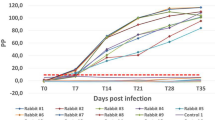Abstract
THE West African N'Dama breed of cattle shows a remarkable tolerance to trypanosomiasis, as was demonstrated by Chandler1. In order to investigate the nature of this tolerance, it was necessary to develop a technique which would give a quantitative estimation of antibody titre. Methods employed in the study of bacteriological immunity are not generally applicable to the study of the immune response as it occurs in African trypanosomiases. Tests such as the mouse protection test employed by Fiennes2 in studying T. congolense infections do not readily give a quantitative estimate of antibody titre and are operative only when the trypanosomes survive in the host as a patent or latent infection.
This is a preview of subscription content, access via your institution
Access options
Subscribe to this journal
Receive 51 print issues and online access
$199.00 per year
only $3.90 per issue
Buy this article
- Purchase on Springer Link
- Instant access to full article PDF
Prices may be subject to local taxes which are calculated during checkout
Similar content being viewed by others
References
Chandler, R. L., Ann. Trop. Med. Parasit., 46, 127 (1952).
Fiennes, R. N. T.-W., Ann. Trop. Med. Parasit., 44, 42 (1950).
Desowitz, R. S., and Watson, H. J. C., Ann. Trop. Med. Parasit., 46, 92 (1952); 74, 247 (1953).
Author information
Authors and Affiliations
Rights and permissions
About this article
Cite this article
DESOWITZ, R. Effect of Antibody on the Respiratory Rate of Trypanosoma vivax . Nature 177, 132–133 (1956). https://doi.org/10.1038/177132b0
Issue Date:
DOI: https://doi.org/10.1038/177132b0
This article is cited by
-
Antigens of Brucei Trypanosomes
Nature (1962)
Comments
By submitting a comment you agree to abide by our Terms and Community Guidelines. If you find something abusive or that does not comply with our terms or guidelines please flag it as inappropriate.



